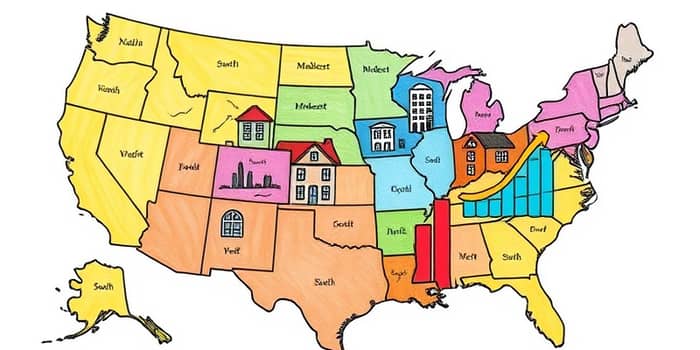The American housing market stands at a pivotal juncture in 2025, balancing between recovery and caution. After the sharp disruptions of recent years, buyers and sellers alike are navigating a landscape marked by slow price growth, rebounding supply, and persistent affordability challenges.
From bustling coastal metros to emerging secondary cities, regional dynamics increasingly define the outlook. Providers, investors, and prospective homeowners must understand where the action is strongest, and where risks remain elevated.
U.S. Market Overview 2025: The Big Picture
Nationally, the average U.S. home value is $368,581, reflecting a modest 0.3% year-over-year increase as of July 2025. While prices rise slowly, supply begins to recover, helping to ease competition and lengthen negotiating windows for buyers.
Across the country, units typically go pending within 20 days, and the inventory is increasing nationwide in July. With 1,374,453 for-sale homes and 402,816 new listings, the market shows signs of normalization after historically tight conditions.
Regional Performance: Where the Action Is
Not all markets move in tandem. Active and new listings have climbed year-over-year in every major U.S. region, but the pace and price impacts vary:
The South leads the recovery, down just 7.5% from pre-pandemic listing norms, while the Northeast remains furthest from full recovery at –26.6%. In the West, a surge in inventory contrasts with slight price declines, offering buyers more leverage.
Key Sunbelt and Southern markets—Nashville, San Antonio, Houston, Jacksonville—are outperforming broader regions, boasting strong seller activity and quick absorption rates. Midwest and Northeast markets continue to show new listings have increased year-over-year, but price appreciation remains muted.
Coastal California tells a nuanced story: Los Angeles and San Diego enjoy modest growth, while the Bay Area faces slight declines amid high costs. Overall, California home sales climbed 10.5% in 2025, with a 4.6% median price uptick.
The Mountain West and Gulf Coast, once red-hot during the pandemic, have cooled as construction ramps up. Buyers in Austin and Sarasota benefit from heavy incentives and price reductions, while builder promotions abound in overbuilt boomtowns.
Sector Spotlight: Residential to Industrial
Beyond single-family residences, commercial real estate segments reveal divergent trajectories:
- Multifamily: New construction starts are 74% below 2021 peaks, creating tight but improving vacancy rates, especially along the East Coast and in Sunbelt absorption markets.
- Retail: As consumer spending slows, store closures are set to double, with vacancy rising in weaker corridors but resilience in fast-growing Sunbelt towns.
- Industrial: Vacancy may peak at a relatively low rate in 2025, paving the way for rental growth acceleration in 2026 amid robust logistics demand.
- Commercial Mixed-Use: High-quality office and retail assets in vibrant urban cores outperform lower-tier properties, driven by tenant preferences and ESG considerations.
Migration plays a pivotal role: demand shaped by migration patterns out of high-cost metros bolsters Sunbelt and Mountain West markets, although some boomtowns now face inventory pressure.
Risks and Opportunities: Affordability, Supply, Investment Focus
Affordability remains the primary constraint. Persistent mortgage rates above historical norms limit move-up and first-time buyer activity, swelling renter demand and strengthening multifamily fundamentals.
Supply dynamics vary: the West and South see rising inventory, while the Northeast still grapples with historically low listings. Policy shifts, from zoning reforms to rent controls, could reshape local balances.
Builder incentives, pronounced in overbuilt markets like Florida and Texas, help stimulate activity but carry the risk of downward price pressure. Meanwhile, consumer sentiment softens, raising downside risks to retail and residential sectors alike.
Emerging and Notable Markets
Certain metros stand out for year-over-year gains in new listings and market vibrancy:
- Nashville, San Antonio, Houston, Jacksonville: Above pre-pandemic listing levels, quick absorption
- Milwaukee (+18.5%), New York (+18.3%), Indianapolis (+14.6%): Top growth in newly listed homes
Investors and developers eye these markets for balanced growth prospects and improving affordability relative to coastal peers.
Longer-Term Outlook and Global Context
The severe real estate reset of 2023–2024 appears largely over, with 2025 emerging as a rebound year for capital deployment. Institutional investors are refocusing on core assets and specialized sectors.
Globally, there is a rising need for affordable housing and strong interest in alternatives such as data centers, logistics facilities, and life sciences campuses. Emphasis on focus on Environmental, Social, Governance criteria in property investment shapes funding flows.
As international capital selectively returns to prime U.S. markets, stakeholders must remain agile. Identifying regional variances, aligning with demographic shifts, and anticipating policy changes will be critical to capturing opportunity.
Ultimately, the 2025 real estate landscape demands a nuanced, regionally informed strategy. Whether focusing on resilient Sunbelt suburbs, balanced Midwest towns, or premium coastal enclaves, success hinges on adapting to evolving market forces and embracing innovation in development and investment.
References
- https://www.aberdeeninvestments.com/institutional/insights-and-research/north-america-real-estate-market-outlook-q2-2025
- https://firstteam.com/blog/market-predictions-for-2025-the-future-of-the-us-real-estate-landscape
- https://www.zillow.com/home-values/102001/united-states/
- https://www.realtor.com/research/june-2025-data/
- https://www.nar.realtor/research-and-statistics
- https://www.resiclubanalytics.com/p/the-50-tightest-housing-markets-heading-into-spring-2025
- https://www.nuveen.com/en-us/insights/real-estate/real-estate-outlook-2025
- https://www.realtor.com/research/july-2025-data/










